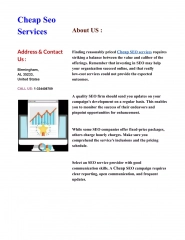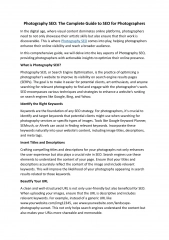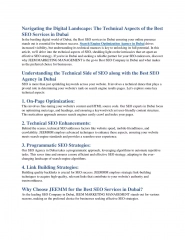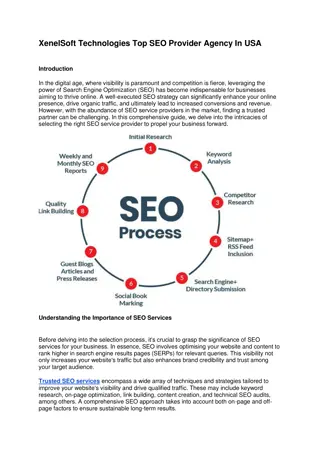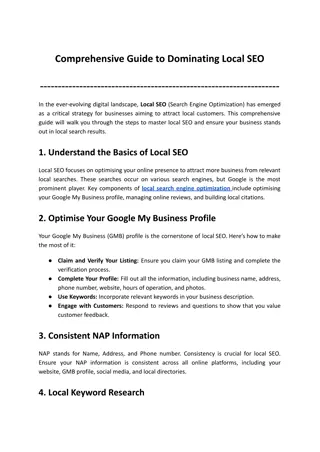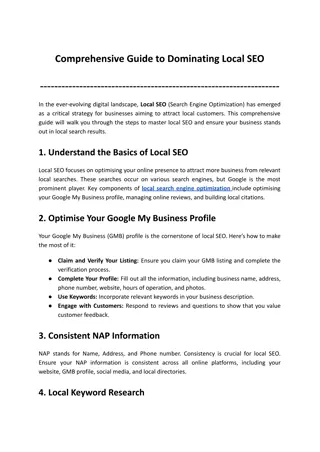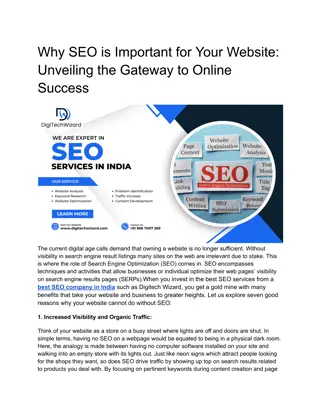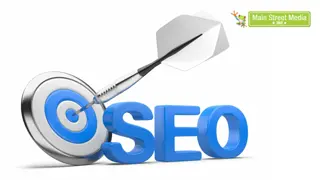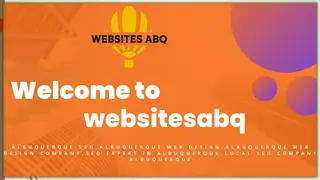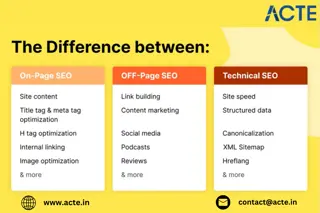
Mastering the Art of Link Location in Content_ Enhance User Experience and SEO
In digital marketing and SEO, every website owner or content creator aims to drive traffic, increase engagement, and convert visitors into loyal customers. One essential element that can significantly impact these goals is the strategic placement of links within your content.
Download Presentation

Please find below an Image/Link to download the presentation.
The content on the website is provided AS IS for your information and personal use only. It may not be sold, licensed, or shared on other websites without obtaining consent from the author. If you encounter any issues during the download, it is possible that the publisher has removed the file from their server.
You are allowed to download the files provided on this website for personal or commercial use, subject to the condition that they are used lawfully. All files are the property of their respective owners.
The content on the website is provided AS IS for your information and personal use only. It may not be sold, licensed, or shared on other websites without obtaining consent from the author.
E N D
Presentation Transcript
Mastering the Art of Link Location in Content: Enhance User Experience and SEO Introduction: In digital marketing and SEO, every website owner or content creator aims to drive traffic, increase engagement, and convert visitors into loyal customers. One essential element that can significantly impact these goals is the strategic placement of links within your content. This article will talk about the importance of link location, how it affects both digital marketing and SEO efforts, and provide actionable tips to optimise your link placement strategy. The Power of Link Location in Digital Marketing:
Link location is crucial in digital marketing by influencing user behaviour and driving engagement. When strategically placed, links can significantly impact the success of your marketing efforts. Here are some key points highlighting the power of link location in digital marketing: Enhanced User Experience: Placing links strategically within your content can improve the overall user experience. Well-placed links provide relevant and valuable information to users, guiding them through your website and encouraging them to explore further. By ensuring that connections are contextually pertinent and seamlessly integrated into your content, you can improve user satisfaction and increase the chances of conversion. Increased Click-Through Rates: The location of a link within your content can significantly impact its click-through rate (CTR). Links positioned prominently, such as within the introductory paragraphs or in visually prominent areas, tend to attract more attention from users. By strategically placing links in high-visibility locations, you can enhance the likelihood of users clicking on them and engaging with your content or desired call-to-action. Guided User Journey: Links strategically placed throughout your content can help guide users along a desired path or conversion funnel. By placing links strategically at relevant points within your range, you can lead users to the next step in their customer journey. SEO Benefits: The placement of links within your content can also positively impact your website's search engine optimisation (SEO). Search engines, like Google, consider the relevance and authority of links when ranking web pages. Well-placed links that are contextually relevant to the surrounding content can signal to search engines the importance and credibility of your website. It, in turn, can lead to improved search engine rankings and increased organic traffic. Link Location's Impact on SEO: Link location plays a crucial role in search engine optimisation (SEO) as it directly affects how search engine crawlers understand and interpret your website's content. Proper link placement can significantly impact your website's visibility and rankings (SERPs). Here are some key points highlighting the impact of link location on SEO:
Crawlability and Indexability: Search engine crawlers follow links to discover and index web pages. Placing links in prominent locations, such as within the main body of the content or near the top of the page, makes it easier for crawlers to find and navigate through your website. When search engines can efficiently crawl and index your web pages, the chances of your content getting included in search results increase. Contextual Relevance: Link location within the content provides search engines valuable context about the linked page's relevance and relationship to the surrounding text. When search engines analyse the anchor text and its content, they gain insights into the topic and subject matter. It helps search engines know the purpose of the link and associate it with relevant keywords and topics, contributing to improved keyword rankings. Internal Link Structure: Link placement influences the internal link structure of your website. By strategically linking relevant pages together, you can establish a hierarchy and flow of information within your website. Well-structured internal linking improves user navigation. It can result in higher rankings for important pages and a better overall user experience. Page Authority Distribution: Links placed in prominent locations, such as within the main body of the content or navigational menus, carry more weight and influence the distribution of page authority. When authoritative pages link to other pages on your website, they pass along some of their credibility and ranking power. It can boost the linked pages' visibility and rankings, especially if placed in high-impact locations. User Engagement Signals: Link location can impact engagement signals such as click-through and bounce rates. When links get placed in easily noticeable and accessible positions, users are likelier to click on them, leading to higher engagement rates. Positive user engagement signals, such as time spent on the site and lower bounce rates, can indirectly influence SEO by indicating to search engines that your content is valuable and relevant. Best Practices for Optimising Link Placement: Contextual Relevance: Ensure the anchor text and surrounding content are closely related to the linked page. It helps search engines know the purpose of the link and provides a seamless user experience.
Above-the-Fold Placement: Position essential links within the top portion of your webpage, also known as the above-the-fold area. Users tend to focus more on immediately visible content, increasing the likelihood of engagement. Use Relevant Keywords: Incorporate relevant keywords in the anchor text of your links to signal their importance to search engines. However, avoid over-optimisation or keyword stuffing, as it can harm SEO. Internal and External Link Balance: Maintain a healthy balance between internal and external links. Internal links help establish site structure and improve user navigation, while external links to authoritative sources can enhance credibility and SEO. Utilise Visual Cues: Use design elements like bold text, different colours, or icons to distinguish links from the surrounding content visually. It can draw attention to the links and encourage clicks. Monitoring and Iterating: Analytics Tools: Analytic tools provide valuable insights into metrics such as conversion, bounce rates, and user behaviour. Performance Analysis: Analyse the collected data to understand your links' performance. Identify patterns and areas that require improvement. Look for links that are generating high engagement and conversions and those that are underperforming. Identify Success Factors: Determine the factors contributing to the success of well-performing links. Are they placed in prominent positions? Do they have compelling anchor text? Understanding the elements that make certain links successful will help you replicate those factors in other content areas. Address Underperforming Links: Evaluate links that are not generating the desired results. Identify potential reasons for their underperformance. It could be due to poor placement, irrelevant anchor text, or lack of visibility. Develop strategies to improve these links by adjusting their order or making them more contextually relevant. A/B Testing: Conduct A/B tests by trying different variations of link placement to see which ones yield better results. For example, you can experiment with anchor texts, positions, or design elements to determine the most effective approach. Compare the performance of
each variation and make data-informed decisions about which version to implement. Continuous Optimisation: The process of monitoring and iterating is ongoing. As you gather more data and insights, optimise your link placement strategy. Make incremental adjustments based on the performance data to maximise click-through rates, conversions, and user engagement. Stay Updated: Keep up with industry trends and best practices in digital marketing and SEO. Strategies and user behaviours evolve, so staying informed allows you to adapt your link placement strategy accordingly and remain competitive. Conclusion: Strategic link placement is a critical component of successful digital marketing and SEO. Understanding the importance of link location and implementing best practices can enhance the user experience, drive traffic, improve rankings, and help you achieve your conversion goals. Continuously optimise your results by monitoring and adapting your link placement strategy based on data-driven insights. SEARCH ENG

